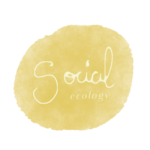Human
Ecology
understanding our interaction with nature
In today’s Western society, we see ourselves as entirely separate from Earth’s ecosystem. Nature has become something to command and use for our own purposes. This individualistic perspective has led to a wide array of environmental and mental imbalances. It’s clear that we need an alternative approach to the natural world and our relationship with(in) it.
Our conceptualization of Human Ecology, based on deep ecology, may provide a valuable starting point here. Deep ecology emphasizes the interconnection between all living and non-living things and the inherent value of each, independent of its usefulness for humans. Indeed, we’re not separate or elevated above all else. Our existence is a mosaic of all our interactions with planet Earth, other humans, ourselves and spiritual experiences.
Four pillars of Human Ecology


Earth ecology refers to every interaction between living and non-living factors (e.g. light) on planet Earth. As humans, we take part in these interactions, albeit often unconsciously. Although we might not perceive them with our senses, we must be aware that these interactions exist and influence us.
Examples: Influence of the sun and the moon, interaction of trees with their surroundings, mycelial network.

Social ecology studies how humans interact with their surroundings and how this affects society and the environment as a whole. Our interactions are influenced by the systems and stories we’ve created for ourselves. As they’re context-dependent, it’s important to stay critical and remember that these social constructs are not universal truths.
Examples: Impact of consumerism on society, power over paradigm, norms and values within groups and society, EU Youth Strategy.

Self ecology is based on the concept of the Ecological Self by Norwegian philosopher Arne Naess. He argues that through self-actualisation, one transcends the idea of the individuated ego-self and comes to see oneself as an ecological self, interwoven with the rest of life on earth. Environmentally-responsible behaviour then becomes an act of self-interest.
Examples: Self-knowledge and self-development work, awareness of our impact on the planet and acting upon it.

Spiritual ecology recognizes that we cannot rationally understand everything about the physical world, encounters, and situations. It also relates to the ecological crisis, as we need to shift our mindset about our connection to nature and take action that embodies this shift.
Examples: Rituals and ceremonies, falling in love, burning a candle for a loved one.
Human ecology in practice
Heads, Hearts, Hands framework
The The Heads-Hearts-Hands framework offers a model for youth workers to explore Human Ecology in practice. This model was introduced by environmental professor and educationalist David Orr. As these crucial body parts are easy to recognize, they’re an excellent basis for working with young people on finding a healthy balance between them. We use Heads, Hearts and Hands in the plural as personal growth is not an individual process, but one shared with and in interaction with others. In this way we actively work towards belonging .

Heads
“Heads” refers to rational thinking and the co-creation of knowledge. It also includes different modes of consciousness that are part of the human psyche, embodied in the nervous system and embedded in human relationships within nature.
Hearts
“Hearts” refers to our emotional framework of meanings and values. Moreover, it includes the energetics of life manifested in our modes of perception and capacity for interconnection and empathy with all that exists.
Hands
“Hands” refers to our physical bodies and capacity for action. Furthermore, it includes the different modes of will and imagination for active participation in the co-creation of a better world.
Motivation & engagement
Self-determination towards well-being
In the process towards individual and collective well-being, self-determination is essential. Self-determination leads to intrinsic motivation, which boosts engagement and a sense of being and feeling well. The Self-Determination Theory (Ryan & Deci, 2017) shows us the aspects we as youth workers should focus on to keep Young people motivated in challenging themselves in their exploration to connect differently to nature, and the impact this has on their wellbeing.

Competence
Competence refers to feeling capable of effectively interacting with your environment and possessing the necessary skills for success and achieving your goals. A competent person experiences a sense of mastery over their environment.
Autonomy
Autonomy involves being able to make your own decisions and is associated with feeling independent. A sense of autonomy is enhanced when individuals are given a choice and are able to govern their own behaviour, and when other people acknowledge their feelings.
Relatedness
Without connections, self-determination is harder to achieve because the individual would lack access to both help and support. Feelings of relatedness are enhanced when individuals are respected and cared for by others and are part of an inclusive environment.
Awareness of comfort-stretch-panic

Like all other mammals, we have two modes of being: stressed or relaxed. This is a very efficient system for most species, as stress causes them to take action when in danger. In current society, humans face a lot of non-life-threatening stress factors like high expectations from others or ourselves. Too much and prolonged stress can cause us to block and hinder the natural learning process. CSP will give you the right language with your youngsters to find the balance between learning and dealing with stress. .
What’s more?
Other resources on strengthening nature connection
With the previous models and theories, we want to offer youth workers a refreshing view on the importance of (re)connecting with nature for individual and collective well-being. Furthermore, we aim to give them practical tools and stepping stones to explore this new awareness with others. This will not only benefit the mental health of the youngsters they work with, but also contribute to a long-term positive impact on the planet.
We see the process of learning about nature connection and its importance for our well-being as a cycle of (re)awakening, activating and cultivating.
The following resources are complementary in stimulating this natural learning process.
©
Illustrations by Maria Giró.
Logo design by Maria Lesnikova.


